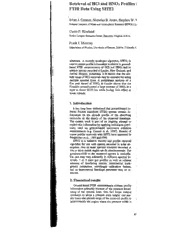
Retrieval of HCl and HNO3 Profiles from Ground-Based FTIR Data Using SFIT2 PDF
Preview Retrieval of HCl and HNO3 Profiles from Ground-Based FTIR Data Using SFIT2
Retrieval of HC1 and HNO3 Profiles J FTIR Data Using SFIT2 Brian J. Connor, Nicholas B. Jones, Stephen W. '_ National Institute of Water andAtmospheric Research(NIWA), L_ Curtis P. Rinsland NASA Langley Research Center,Hampton,Virginia,U.S.AI Frank J. Murcray Department of Physics, University ofDenver, Denver, Colorado, L Abstract. A recently developed algorithm, sFrr2, is used to assess profile information available in ground- based FrIR measurements of HCI and HNO3 and to analyze spectra recorded at Lauder, New Zealand, and Arrival Heights, Antarctica. It is shown that the alti- tude range of HCI retrievals may be extended byusing multiple spectral lines. A preliminary analysis of a five year record of HNO3 at Lauder shows that the Pinatubo aerosol caused a large increase of HNO3 in a layer at about 20-30 km while having little effect at lower altitude. 1. Introduction It has long been understood that ground-based in- frared Fourier transform (FFIR) spectra contain in- formation on the altitude profde of the absorbing molecules in the details of the observed lineshape. The current work is part of an ongoing attempt to exploit this information by applying techniques previ- ously used on ground-based microwave emission measurements (e.g. Connor et al., 1995). Results of ozone profile retrievals with SFrI_ have appeared in Pougatchev et al., 1995 and 1996. SFrI'2 is a radiative transfer and profile retrieval algorithm for use with spectra recorded in solar ab- sorption. One or more spectral windows recorded at one or more zenith angles are fit simultaneously. The goodness-of-fit to the measured spectra is controlla- ble, and may vary arbitrarily in different spectral in- tervals. I or 2 trace gas profiles as well as column amounts of interfering species, instrumental back- ground parameters, wavelength calibration factors, and an instrumental lineshape parameter may be re- trieved. 2. Theoretical results Ground-based _ measurements contain profile information primarily because of the pressure broad- : ening of the spectral lines. This fact limits vertical resolution to about a pressure scale height, and usu- i ally limits the altitude range of the retrieved profile to approximately the region where the pressure width is 4_
